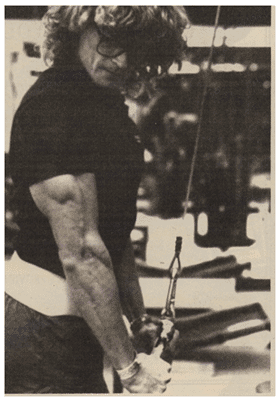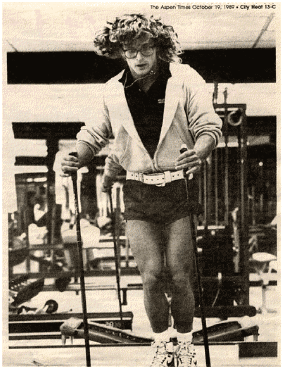
Ski Conditioning is Serious Stuff

People walking about town with ski boots in tow are probably on the way to a ski conditioning class. Avid skiers know that preseason "sport specific" conditioning is vital for injury prevention, endurance, flexibility and quick reflexes, not to mention avoiding looking like a total fool on opening day. And that big day is only five weeks away. Obviously, the earlier one starts conditioning for skiing the better. "Ten weeks is better than five weeks," says Eileen Hinchliffe, an aerobics instructor and program director for Colorado Mountain College, "but five weeks is better that nothing. Once a week - forget it!" The biggest cause of injury during skiing is muscles pushed further than they should be, says Hinchliffe, who notes that the most likely time for injury is at the end of a day of skiing after fatigue has set in. Hinchliffe teaches a lunch hour aerobics class that is gearing towards ski season, with emphasis on cardiovascular workouts and leg strengthening exercises. "People like to feel good and secure when they get out there the first time," says Marisa Post of the Aspen Athletic Club.
Emphasis of the athletic club's conditioning classes is on high impact aerobics, leg work, flexibility and mobility. Other popular ski conditioning activities include ice skating, roller blading and bicycling. For the ultimate in ski conditioning, many people are turning to one-on-one training with a personal instructor. These sessions, though expensive, offer personally tailored and paced exercises designed to make skiers feel as though their last run was yesterday. The payoff comes, according to Ultimate Results personal trainer Conan Angelo, that first day of skiing. "You discover it when you slip your boots on and think, "Boy, I didn't lose anything."
He and fellow trainer Jean-Robert Barbette demonstrate some of the many awkward positions skiers find themselves in, and point out the muscles that come into play during these moments. The more typical day-to-day physical pursuits of bicycling, swimming and such don't necessarily tap into these muscles and tendons. Barbette easily falls into a "plie", a ballet movement in which the legs are bent into a perpendicular position with back straight and feet pointing out to the sides. Only dancers would routinely find themselves in this position, and people taking ski conditioning classes. "Skiing is a dance, when you get good enough," says Angelo. Jean-Robert , a Belguim man who used to race with the junior French ski team and later became the indoor trainer for the team, explains the intensive one-hour session at Ultimate results. People are encouraged to come in 10 to 15 minutes early to warm up on the stationary bike. In class, they start out on a small trampoline with its sides tilted slightly up. For 10 or 15 minutes they jump softly, side to side, mimicking the familiar skiing motion. "It's a nice warm-up" says the trainer.
During this exercise, he shows how people typically take one huge breath and hold it during these movements. But that is incorrect. He emphasizes proper breathing and how to catch the maximum amount of oxygen at the best opportunity. Next he moves to a bench and from a standing position on the floor, jumps up softly onto it, into a standing position. This could be expanded to jumping up, pausing, and jumping softly down again to the front. Other machines in the gym use small repetitious movements to work the front tibial muscles along the shins ("This is where the first fatigue you have is," says Jean-Robert) the quads, the hamstrings in the back of the legs, the forearms, and the triceps. Stomach exercises, called "crunches", are emphasized to help prevent back injuries. Jean-Robert takes his clients through a slow warmup, an "explosive workout" and a slow cool-down, all lasting about an hour, sometimes longer. Light weights (two to three pounds) are sometimes strapped on the legs for a better workout, and later, ski boots may even be added to simulate the real thing. Jean-Robert has just begun offering a group class, of no more than five at a time, for the ski conditioning. Geared to working locals, the class is only $15/hr and held in the evenings. There are still openings. Aspenites take their skiing very seriously, indeed.

